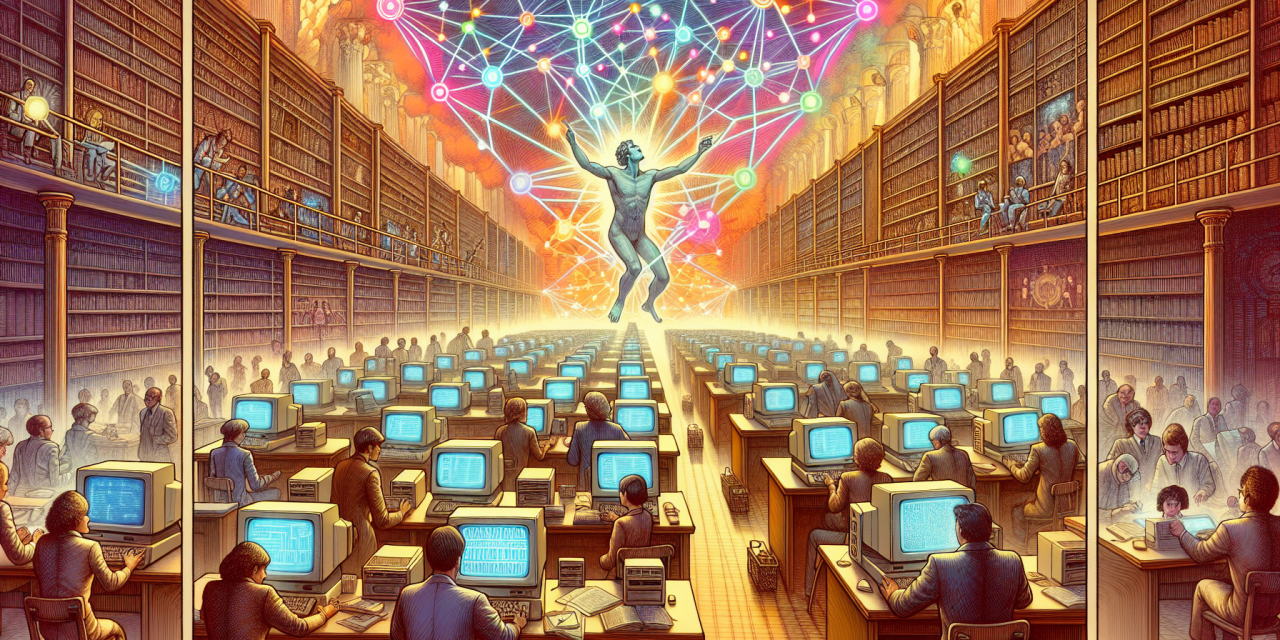Picture this: you’re a brilliant physicist working at CERN in the late 1980s, surrounded by thousands of incredibly smart people from dozens of countries. Everyone has fascinating research, groundbreaking discoveries, and innovative ideas. But here’s the problem—all this amazing knowledge is trapped in separate computer systems that can’t talk to each other. It’s like having the world’s best library where each book is locked in its own vault, and nobody has all the keys.
This was exactly the frustration that drove Tim Berners-Lee to create something that would fundamentally change how we share, learn, and collaborate. He didn’t set out to revolutionize the world—he just wanted to help scientists stop wasting time hunting for information that was sitting right there, tantalizingly out of reach.
The Problem: Information Islands in an Ocean of Knowledge
Imagine you’re trying to bake the perfect chocolate chip cookies. You know your grandmother has the best recipe, your chemistry teacher understands exactly why certain ingredients work together, your friend’s mom knows the perfect baking temperature, and the local baker has mastered the timing. But here’s the catch—they all live in different countries, speak different languages, and have no way to easily share what they know with each other or with you.
That’s essentially what CERN looked like in 1989. Researchers had IBM computers that couldn’t communicate with Apple computers. Scientists in one department had no easy way to access research from another department. Valuable information was scattered across incompatible systems like puzzle pieces dumped into separate boxes.
Tim Berners-Lee saw this chaos and thought, “What if we could create a web-like structure where any piece of information could connect to any other piece of information?” Notice he called it a “web”—not because spiders were involved, but because he envisioned information connected in all directions, just like the intricate patterns spiders weave.
The Breakthrough: Thinking Beyond Files and Folders
Here’s where Tim’s thinking became truly revolutionary. Instead of trying to force all the different computer systems to become identical (which would be like making everyone in the world speak the same language), he created a universal translator system. But this translator didn’t just convert words—it connected ideas.
He invented three fundamental tools that work together like a coding trio:
HTML (HyperText Markup Language): Think of this as a universal formatting language. Just like you might underline important words in your notebook or draw arrows between related concepts, HTML lets you mark up digital documents so any computer can understand their structure.
HTTP (HyperText Transfer Protocol): This is like a polite conversation system for computers. When you want to access information, your computer uses HTTP to ask another computer, “May I please have that document?” and the other computer responds appropriately.
URLs (Uniform Resource Locators): These are like precise addresses for information. Just as your home has a unique address that lets mail carriers find you anywhere in the world, URLs give every piece of web information its own unique location.
The Magic of Hyperlinks: Connection Creates Intelligence
But Tim’s most brilliant insight was the hyperlink—those clickable connections that let you jump from one piece of information to another. This feature might seem obvious now, but imagine explaining it to someone in 1989: “You’ll be reading about penguins, and if you click on the word ‘Antarctica,’ it will instantly transport you to a document about ice formations, written by someone completely different, stored on a computer thousands of miles away.”
Hyperlinks do something magical—they let information become more than the sum of its parts. When you connect related ideas, you create new pathways for understanding. It’s like being able to instantly teleport between any related thought in a massive, ever-growing encyclopedia that the entire world is writing together.
This connecting power transforms how we learn. Instead of reading linearly from A to Z, you can follow your curiosity. Reading about volcanoes? Click through to geology, then to plate tectonics, then to earthquakes, then to building safety, then to architecture. Your learning path becomes as unique as your interests.
Share Everything, Hoard Nothing: The Open Philosophy
Perhaps Tim’s most consequential decision was making the World Wide Web completely free and open. He could have patented his inventions and become incredibly wealthy. Instead, he chose to give his creation to humanity as a gift.
This wasn’t just generosity—it was strategic brilliance. Tim understood that a network becomes more valuable as more people join it. It’s like the telephone system: the first person with a telephone couldn’t call anyone, but as more people got telephones, everyone’s phone became more useful.
By keeping the web open, Tim ensured that anyone could contribute, anyone could access information, and anyone could build something new on top of his foundation. This decision unleashed an explosion of creativity and innovation that continues today.
From Sharing Papers to Sharing Everything
What started as a way for scientists to share research papers quickly evolved into something nobody could have predicted. People began sharing personal stories, family photos, business ideas, educational resources, entertainment, art, music, and entire communities.
The web became a collaborative canvas where millions of people simultaneously create, critique, and build upon each other’s work. Open-source software projects demonstrate this beautifully—programmers around the world contribute code, report problems, suggest improvements, and create tools that benefit everyone.
Learning transformed from a solitary activity into a social one. Instead of struggling alone with a math problem, you can find video explanations, interactive tutorials, practice problems, and study groups. Instead of wondering about a historical event, you can access primary sources, expert analyses, and diverse perspectives from around the globe.
Your Turn: Reimagining the Web
Tim Berners-Lee solved the problems he saw in 1989, but what problems do you see in 2024? If you could add one new feature to the web, or change how it works, what would you choose?
Maybe you’d create better ways to verify true information. Perhaps you’d design systems that help people with different viewpoints have more productive conversations. You might invent tools that make learning more personalized, or ways to ensure everyone has equal access to information regardless of where they live.
The beautiful thing about Tim’s story is that it shows how one person’s frustration with inefficiency led to a tool that empowers billions of people to learn, create, and collaborate. His solution grew far beyond his original vision because he built something flexible and open that others could expand.
What inefficiencies or barriers do you notice in your own learning, creating, or collaborating? The next revolutionary tool might come from someone who approaches these everyday frustrations with a coder’s mindset: breaking down problems, imagining ideal solutions, and building connections that didn’t exist before.
After all, the most powerful technologies often start with someone simply asking, “Why does this have to be so difficult?” and then having the persistence to build something better.
Origins: The Spark of an Idea
In 1989, Tim Berners-Lee was working at CERN when he faced a frustrating problem that would ultimately change the world. The key moments that led to the World Wide Web’s creation include:
- March 1989: Tim Berners-Lee submits his proposal “Information Management: A Proposal” to CERN management
- 1990: Development begins on the first web browser (called WorldWideWeb) and web server
- August 1991: The first website goes live at info.cern.ch
- 1993: CERN announces the World Wide Web will be free for everyone to use
These weren’t just technical milestones—they were moments when human connectivity took a quantum leap forward.
Impact on Knowledge Sharing: A Revolution in Learning
The Web transformed how we access and share knowledge:
- Democratized information: Anyone could publish and access information globally
- Eliminated geographical barriers: A student in rural Kenya could access the same resources as one at Harvard
- Created new forms of collaboration: Wikipedia, open-source projects, and online communities flourished
- Accelerated scientific progress: Research could be shared instantly across continents
- Enabled distance learning: Online education became accessible to millions
“The original idea of the web was that it should be a collaborative space where you can communicate through sharing information.” —Tim Berners-Lee
Coding Lessons for Today: Berners-Lee’s Developer Principles
Modern developers can learn crucial principles from Tim Berners-Lee’s approach:
1. Solve Real Problems: Tim didn’t create the Web for fame or money—he solved a genuine pain point at CERN.
2. Build for Interoperability: His three core technologies (HTML, HTTP, URLs) were designed to work across different systems.
3. Embrace Open Standards: By keeping the Web open and free, Tim enabled exponential growth and innovation.
4. Think Beyond Your Use Case: The Web grew beyond scientific papers because Tim built flexible, extensible tools.
“We need diversity of thought in the world to face the new challenges.” —Tim Berners-Lee
The Future of the Web: Continuing the Vision
Tim Berners-Lee continues to shape the Web’s evolution through the World Wide Web Consortium (W3C) and his work on data ownership and privacy. His current focus includes:
- Solid Project: Giving users control over their personal data
- Web accessibility: Ensuring the Web works for people with disabilities
- Fighting misinformation: Developing tools for information verification
- Digital rights: Advocating for an open, decentralized Web
The Web’s next chapter will be written by developers who embrace Tim’s vision of universal access, open collaboration, and human-centered technology.
Further Viewing
The World Wide Web: Tim Berners-Lee’s Original Vision – A TED Talk where Tim Berners-Lee discusses the Web’s past, present, and future, including his concerns about data ownership and digital rights.
Tim Berners-Lee: The next Web of open, linked data – In this influential TED presentation, the Web’s inventor outlines his vision for linked data and the semantic web.
Further Reading/Resources
Tim Berners-Lee’s W3C Profile – The official biography and current work of the World Wide Web’s creator at the World Wide Web Consortium.
The Birth of the Web at CERN – CERN’s official account of how the World Wide Web was created, including historical documents and Tim’s original proposal.
World Wide Web Foundation: History of the Web – Comprehensive timeline and analysis of the Web’s development and global impact from Tim Berners-Lee’s own foundation.
The Guardian: Tim Berners-Lee on 30 Years of the World Wide Web – In-depth journalism covering the Web’s evolution and Tim Berners-Lee’s current mission to “save” the internet.
Scientific American: Long Live the Web – Tim Berners-Lee’s own essay on the principles that have made the Web successful and the threats it faces today.








